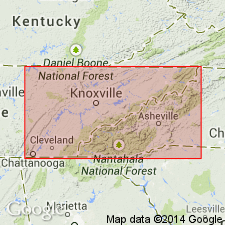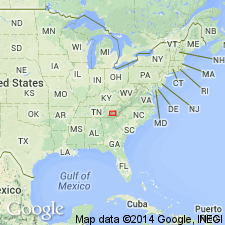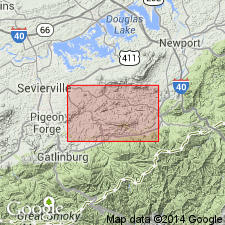
- Usage in publication:
-
- Citico conglomerate*
- Modifications:
-
- Original reference
- Dominant lithology:
-
- Conglomerate
- Sandstone
- Slate
- AAPG geologic province:
-
- Appalachian basin
- Piedmont-Blue Ridge province
Summary:
Pg. 2. Citico conglomerate. Entirely siliceous, varying from fine white sandstone to coarse quartz conglomerate, with a few thin beds of sandy slate. Changes from fine to coarse sediment very sudden and accompanied by changes in thickness from 50 to 800 feet, the coarse beds being thickest. Total thickness of formation 50 to 800 feet. Overlies Wilhite slate and underlies Pigeon slate. Age is Early Cambrian.
[GNC remark (ca. 1936, US geologic names lexicon, USGS Bull. 896, p. 447): Foregoing is original definition of formation. The name, however, was incidentally used by C.D. Walcott in 1894 (GSA Bull., v. 5, p. 196, 197), as "siliceous Citico conglomerate (Keith)," which caps Wilhite slate in Tennessee.]
[Named from Citico Creek, Monroe Co., eastern TN. Extends into western NC.]
Source: US geologic names lexicon (USGS Bull. 896, p. 447).

- Usage in publication:
-
- Citico conglomerate
- Modifications:
-
- Revised
- AAPG geologic province:
-
- Appalachian basin
Summary:
In eastern TN, Citico conglomerate may be used as a member name for conglomerate beds and lenses within Sandsuck Shale, especially south of Miller Cover fault.
Source: GNU records (USGS DDS-6; Reston GNULEX).

- Usage in publication:
-
- Citico conglomerate†
- Modifications:
-
- Abandoned
- AAPG geologic province:
-
- Piedmont-Blue Ridge province
- Appalachian basin
Summary:
Because Citico conglomerate is a characteristic rock type of Walden Creek Group (in redefined Ocoee series), but occurs at so many different stratigraphic levels, it and overlying and underlying slates have no stratigraphic meaning; therefore, Citico conglomerate is abandoned.
Source: GNU records (USGS DDS-6; Reston GNULEX).

- Usage in publication:
-
- Citico conglomerate
- Modifications:
-
- Not used
- AAPG geologic province:
-
- Appalachian basin
Summary:
In his unpublished report on Mount Guyot quad, A. Keith applied the names Hiwassee slate to fine-grained rocks and Citico conglomerate to coarse-grained rocks to rocks here called Walden Creek group; these names have no stratigraphic significance in this area, were derived from geographic features many miles to the southwest, and are not used in this report.
Source: GNU records (USGS DDS-6; Reston GNULEX).
For more information, please contact Nancy Stamm, Geologic Names Committee Secretary.
Asterisk (*) indicates published by U.S. Geological Survey authors.
"No current usage" (†) implies that a name has been abandoned or has fallen into disuse. Former usage and, if known, replacement name given in parentheses ( ).
Slash (/) indicates name conflicts with nomenclatural guidelines (CSN, 1933; ACSN, 1961, 1970; NACSN, 1983, 2005, 2021). May be explained within brackets ([ ]).

